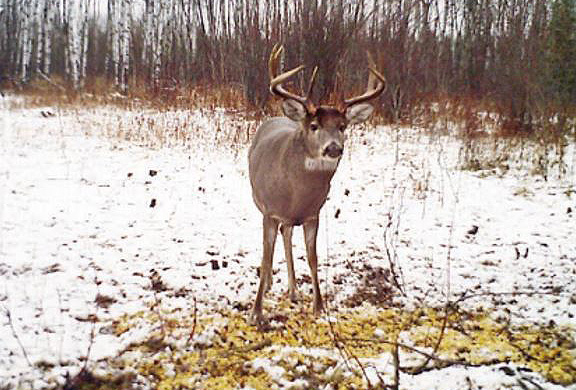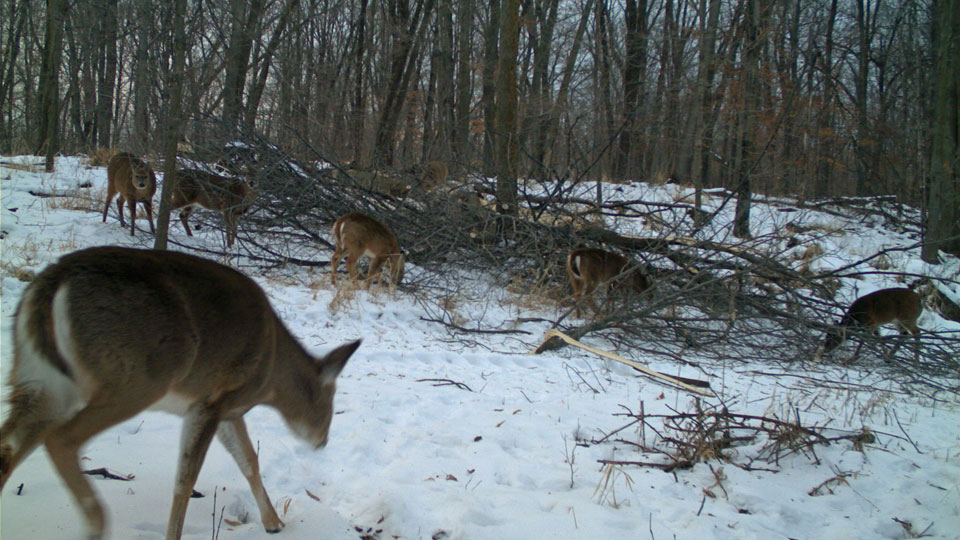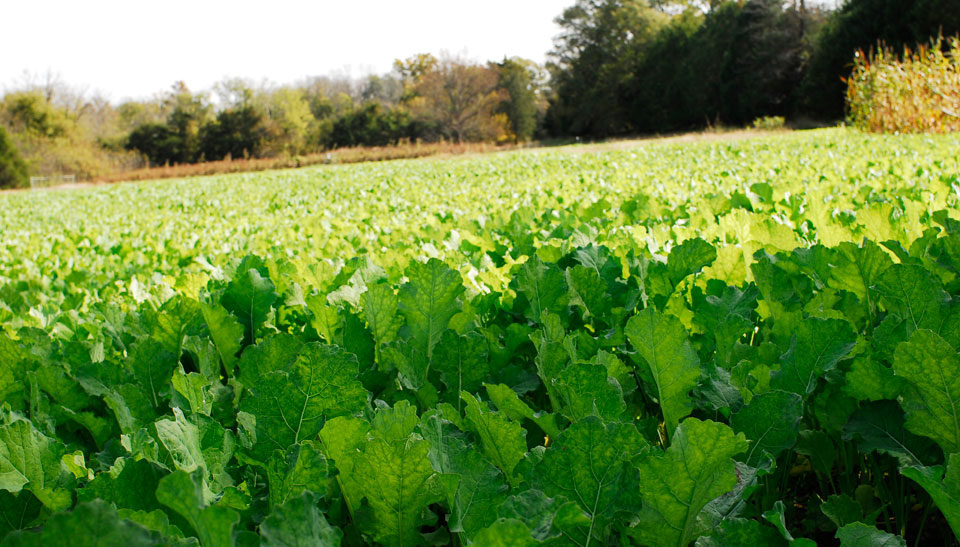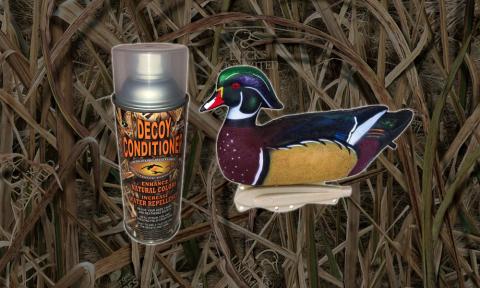Brad Fitzpatrick | Originally published in GameKeepers: Farming for Wildlife Magazine
Winter: The Hardest Season of the Year
When hunting season draws to a close some tend to forget that the hardest season of the year for whitetails has just begun. If you are serious about manufacturing healthy deer herds then consider a supplemental winter deer feeding program.
Autumn is a busy time for both deer and deer hunters. As hunters are clearing shooting lanes, sighting in bows, checking game cameras and hanging stands, at the same time whitetail bucks are busy feeding on high-energy foods like legumes, acorns, and cultivated crops to pack on the additional 30 pounds or so that will be required to last them through the rut. During the rut most bucks will dramatically decrease food intake, in addition to spending tremendous amounts of energy chasing does.
As the rut nears, bucks shift their focus from feeding to patrolling their territory and waiting for the first does to come into estrus. Mature bucks are healthy and fat at the beginning of the rut, using their stores of energy to survive the demanding weeks that follow as they chase does, fight with other bucks and remain on the move both day and night.
Much of the whitetails’ annual cycle is related to the length of day and the resulting effect on the deer’s pineal gland, which regulates hormone levels in the body. The events that occur annually in a deer’s life cycle (antler formation and release and increased testosterone levels in bucks and the estrus cycle in does) are directly related to pineal gland activity and length of days more than any other single factor.
As the rut winds down and hunting season draws to a close, bucks begin trying to regain some of the body mass that was lost during the stress of the rut. Bucks that have survived to the beginning of winter have undergone the trying weeks of chasing does, fighting with other bucks and because their single focus is finding and breeding as many does as possible they stop eating, their food intake can be reduced 90% during this period. So weight loss can be significant as the demands of the season take their toll. When the rut ends bucks are left depleted going into the leanest time of year.

Most deer managers are more than willing to plant their plots in the spring and summer. The weather is pleasant and the anticipation of the fall hunting season serves as the necessary motivation to plant food plots. These plots are generally maintained through the beginning of the hunting season, but when the bucks are beginning to think about does and hunters are preparing to pursue bucks, food plot maintenance typically dwindles.
With the exception of the brief period of intense energy expenditure during the rut, there is no more stressful time in the life of a whitetail buck than winter. In northern climates snow covers much of the ground after the end of the rut, making it even more difficult to find food. Already depleted and worn down from breeding activity, bucks face the prospect of surviving the difficult winter months with a limited supply of food. Extremely harsh winters can make it impossible for bucks to gain back the body mass lost during the rut, leading to increased risk of disease or predation or, in some cases, death.
The Importance of a Winter Food Source for Whitetails
For deer managers, winter is largely ignored. The hunting season has ended, the deer are tagged and processed, and the snow and cold weather have come. In northern regions the days are short and temperatures are low. At that point many deer managers are waiting for spring, looking forward to hunting for shed antlers, planting food plots, and warmer weather. It is important, however, not to forget about managing your deer herd during the winter months. Bucks that survived the hunting season face the prospect of many difficult months with poor forage and the constant caloric burden of maintaining body heat. This stress can last throughout the winter as deer are constantly trying to catch up, always trying to find enough food to sustain them through these difficult times.
There is a significant shift in a whitetail’s metabolism between the spring and summer months and late autumn and winter. Deer are not nearly as active when the weather turns cold, and in response to less food and cold temperatures their metabolism slows greatly, reducing the deer’s need for food.
During the winter months deer growth rates drop dramatically. In essence, deer are simply surviving the cold months in preparation for spring. In some cases their metabolism can slow as much as 50% and the focus of the whitetail’s life becomes finding enough food to survive until the climate improves.
The impact of winter can be affected by your latitude as well. Regardless of your location, whitetail bucks are burning energy and calories during the rut and are entering winter depleted. Ideally, these deer would have a ready food source and would be able to rebuild the fat stores necessary to cope with the stress of winter. In cold northern climates deer eat to survive, trying to find enough food to keep them alive until the weather turns better. Supplemental feeding in winter becomes even more essential in areas where deer face extreme cold and lots of precipitation.
There are a variety of winter stressors—snow, cold temperatures, and a lack of food. Snowfall levels, however, play a major role in the deer’s ability to find food. Heavy snows can be deadly to deer herds, as snow makes traveling more difficult (at the cost of valuable calories) and heavy snows can cover food sources. Deer that have to navigate through and dig below piled snow are using more calories than deer in areas with little snowfall. When accumulated snow levels reach a point where deer have to expend tremendous energy to find their food there is a serious risk for winter die-off, particularly among bucks that are already depleted.

Antler genesis begins again in the spring as days begin to lengthen and temperatures warm. Additionally, does are giving birth to fawns at the end of winter and are lactating, which also places metabolic strains on deer that may already be depleted from winter. With bucks, antler growth is secondary to body condition, so if bucks start the spring in a depleted state, full antler growth may not be achieved.
If you are serious about deer management it is essential not to neglect the winter. This critical time of year makes a big difference when you are trying to grow big antlers and heavy body weights.
As stated previously, a whitetail’s life changes drastically between the end of the rut and the beginning of winter. In the southern United States, where the rut occurs later in the year, bucks have a few short months to scrape by and rebuild fat reserves before spring, and snow cover rarely lasts longer than a week. In northern climates deer spend upwards of five or six months after the rut battling against the cold, snow and food that is difficult to come by.
During the winter all deer focus almost solely on finding food and the less energy they have to spend wading in and digging through snow to find that food the better. When the temperatures drop and a whitetail’s metabolism slows, deer tend to remain on south and west-facing slopes, avoiding the exposure to extreme elements as much as possible. This means that these are natural wintering areas and if tillable land is available near these deer wintering grounds that is where you should plant your supplemental winter plots.
Deer do not require as much energy in winter, as previously stated. However, this information can be misleading because although deer require slightly less feed in the winter there is far less feed available, and heavy snowfall means that the deer will sometimes have to dig to find food. Supplemental winter feeding can provide the calories deer need to maintain sufficient body fat throughout the winter and be prepared for maximum growth in the spring.
“In many parts of the country snow will cover up a lot of the browse and mast so supplemental feed really helps the deer out,” says Dr. Mike Messman of Cargill’s Record Rack division. “The key is to get the feed out there so that the deer can consume it.”
What to Feed Deer in the Winter
Selecting a good winter food plot requires researching what type of supplemental plants will survive in your area during winter. In addition, these plants must be palatable and attractive to deer. Selecting a winter crop can be much more difficult than choosing a warm weather crop because you are limited to choosing plants that can endure the worst winter weather, and a plot that doesn’t survive and produce a food source for the deer is of no value. In selecting the right winter crop for your area it is best to choose food sources that have proven to be hearty and palatable to deer. Brassicas and corn are two standbys in the north simply because your herd can access the food.
Corn has proven to be successful for winter plots because deer can reach the cobs above the deep snow cover and the carbohydrates that corn provides means “heat” for the whitetail’s “boiler room.” Although corn provides poor protein and the yield per acre is not that of other popular food plot crops, it has a solid place in an “all-around program” because of its importance during winter.
Other good choices for winter forage are brassicas (greens and root bulbs) and sugar beets (greens and root bulbs). Both of these food types are favorites of deer because they are palatable and provide the nutrients necessary to help deer thrive during the winter and are particularly high in protein content. Not all brassica varieties produce bulbs, which can be added attraction for deer. Most brassicas are relished for the succulent, high protein, green forage they produce. BioLogic’s Winter Bulbs and Sugar Beets or Maximum are good choices for most late-season food plots and will provide forage that will improve the health of winter deer herds, particularly in times of stress. A brassica/beet mix should be planted in late summer or early autumn depending upon your location north to south.

Winter food plots oftentimes become buried under heavy snow, requiring deer to dig to find food items. In times of heavy snow some managers choose to plow their fields or remove snow with a blade to make it easier for deer to access the plot. In reality, though, deer are pretty hearty animals, and in all but the worst conditions and the deepest snow they will be able to access a known food supply.
Winter can be a critical time for whitetails. Most managers totally forget about their herds when cold temperatures and snow move in and the hunting season is over. If you are serious about managing your deer herd, though, it means year-round maintenance, particularly when deer are faced with the difficulties of finding food in winter. By helping bucks get back on their feet after the rut you’ll find that they are back on pace by spring to grow the most impressive headgear.































